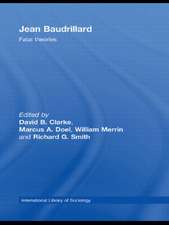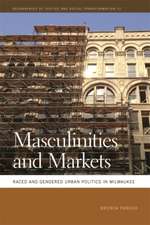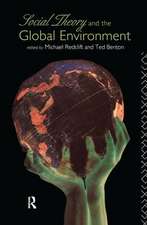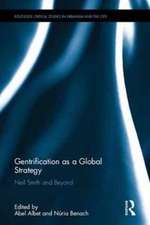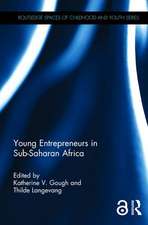Geographies of Violence: Killing Space, Killing Time: Society and Space
Autor Marcus A. Doelen Limba Engleză Paperback – 10 iul 2017
Geographies of Violence is a critical human geography of the history of violence, from Ancient Rome and Enlightened wars through to natural disasters, animal slaughter, and genocide. Written with incredible insight and flair, this is a thought-provoking text for human geography students and researchers alike.
| Toate formatele și edițiile | Preț | Express |
|---|---|---|
| Paperback (1) | 360.32 lei 6-8 săpt. | |
| SAGE Publications – 10 iul 2017 | 360.32 lei 6-8 săpt. | |
| Hardback (1) | 876.61 lei 6-8 săpt. | |
| SAGE Publications – 10 iul 2017 | 876.61 lei 6-8 săpt. |
Preț: 360.32 lei
Nou
Puncte Express: 540
Preț estimativ în valută:
68.95€ • 71.85$ • 57.09£
68.95€ • 71.85$ • 57.09£
Carte tipărită la comandă
Livrare economică 03-17 aprilie
Preluare comenzi: 021 569.72.76
Specificații
ISBN-13: 9781473937697
ISBN-10: 1473937698
Pagini: 232
Dimensiuni: 156 x 234 x 18 mm
Greutate: 0.39 kg
Ediția:1
Editura: SAGE Publications
Colecția Sage Publications Ltd
Seria Society and Space
Locul publicării:London, United Kingdom
ISBN-10: 1473937698
Pagini: 232
Dimensiuni: 156 x 234 x 18 mm
Greutate: 0.39 kg
Ediția:1
Editura: SAGE Publications
Colecția Sage Publications Ltd
Seria Society and Space
Locul publicării:London, United Kingdom
Recenzii
"Do not read this book. Experience it. Never before has such analytical power and narrative brilliance been applied to a subject so universally obscured and evaded -- the endlessly violent geographies of killing times, of killing spaces, of the ruthless efficiencies of optimal, optimized evil. Doel sets out to hit us in the face and the stomach with the myriad horrors of our world, our lives and deaths, and no reader will ever be quite the same after this breathtaking journey through genocides, gulags, and incinerated cities. This is powerful cognitive crystal meth, a stunning work of apocalyptic beauty and catastrophic grace."
Cuprins
The Joy of Killing
Chapter 1: The Best of All Possible Violence
Chapter 2: Once Upon a Time, Long, Long Ago
Chapter 3: Pre-Industrial Mass Killing
Chapter 4: The European Way of War
Chapter 5: Enlightened Killing
Chapter 6: The Animal Slaughter Industry
Chapter 7: The Human Slaughter Industry
Chapter 8: Weaponized Air
Chapter 9: Atmospheric Terrorism
Chapter 10: Black Meteorology
Chapter 11: Firestorms and Corpse Mines
Chapter 12: Capital Punishment
Chapter 13: The Business of Genocide
Still Dead Certain
Chapter 1: The Best of All Possible Violence
Chapter 2: Once Upon a Time, Long, Long Ago
Chapter 3: Pre-Industrial Mass Killing
Chapter 4: The European Way of War
Chapter 5: Enlightened Killing
Chapter 6: The Animal Slaughter Industry
Chapter 7: The Human Slaughter Industry
Chapter 8: Weaponized Air
Chapter 9: Atmospheric Terrorism
Chapter 10: Black Meteorology
Chapter 11: Firestorms and Corpse Mines
Chapter 12: Capital Punishment
Chapter 13: The Business of Genocide
Still Dead Certain
Notă biografică
Marcus Doel is Professor of Human Geography at Swansea University in Wales, where he is also the Deputy Pro-Vice-Chancellor for Research and Innovation, and the Co-Director of the Centre for Urban Theory. Marcus is an alumnus of the University of Bristol, and held positions at Liverpool John Moores University and Loughborough University in England prior to his move to Swansea University in 2000. He is the author of Postculturalist Geographies: The Diabolical Art of Spatial Science (Rowan and Littlefield, Edinburgh University Press), the co-author of Writing the Rural: Five Cultural Geographies (Sage), and the co-editor of Jean Baudrillard: Fatal Theories (Routledge), Moving Pictures/ Stopping Places: Hotels and Motels on Film (Lexington books), and The Consumption Reader (Routledge) amongst other works. Marcus has written and lectured widely on critical human geography, social and spatial theory and post-structuralism, and he has published over 100 articles and book chapters in the related fields.
Descriere
A unique writing style, and comprehensive and international coverage of the history of violence, make this a thought-provoking read for human geographers








